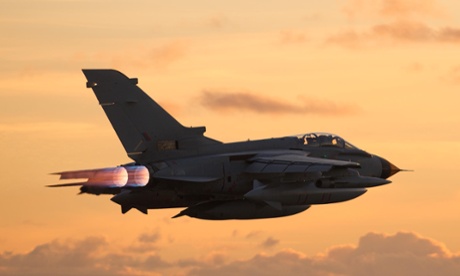BAE Systems Flies High With Additive Manufacturing

An RAF Tornado was the first British fighter to fly with 3D printed parts. Courtesy of BAE Systems.
Latest News
January 6, 2014
It wasn’t even all that long ago that various analysts were dismissive of the ability for additive manufacturing (AM) to disrupt traditional manufacturing methods. They claimed the process was too slow for most uses beyond rapid prototyping or one-off parts production. GE Aviation was the first aerospace company to prove that idea false and other companies have followed suite, finding ways in which AM trumps traditional manufacturing.
BAE Systems has joined the AM fold with its first test run of 3D printed parts. In December, A RAF Tornado GR4 had a successful flight and landing after taking off from the company’s airstrip in Warton, Lancashire. Among the 3D printed parts fitted to the plane were protective covers for cockpit radios, support struts on air intake doors, and guards for power take-off shafts.

The parts were built on-site in a fraction of the time required to prepare a replacement part using older manufacturing methods. Along with time savings, BAE and the RAF reported substantial cash savings. A number of the parts cost less than £100 (around $163) to 3D print, and decreased costs associated with storing, shipping and building the parts could save the RAF around £1.2 million (just shy of $2 million) over a four year period.
Nearly as important is the ability to build 3D printed parts in the field, on a ship, or wherever they might be needed that has enough room for an AM system. The US has already begun to put 3D printers in the field, and the UK may not be far behind.
BAE is also working on leveraging AM to build much larger parts. A partnership with Cranfield University has produced the largest 3D printed parts ever built in the UK. Using a metal printing process the university refers to as Wire+Arc Additive Manufacture (WAAM), researchers were able to print out a 4 ft. long titanium spar section. The part, which is a key component of aircraft wings, required 37 hours to build using AM instead of the weeks required with older manufacturing methods.
“What we’ve been able to demonstrate from this project is that we have the ability to manufacture titanium parts on this scale,” said BAE engineering lead, Matt Stevens. “The next stage is to continue working together to produce more parts and to develop a robust set of processes so that we can take this technology and apply it safely and seamlessly into the aerospace industry.”
Below you’ll find a short video about the parts made for the Tornado. Don’t bother adjusting your volume, BAE didn’t add much in the way of sound.
Sources: Guardian, BAE Systems, Cranfield University
Subscribe to our FREE magazine, FREE email newsletters or both!
Latest News
About the Author
John NewmanJohn Newman is a Digital Engineering contributor who focuses on 3D printing. Contact him via [email protected] and read his posts on Rapid Ready Technology.
Follow DE





